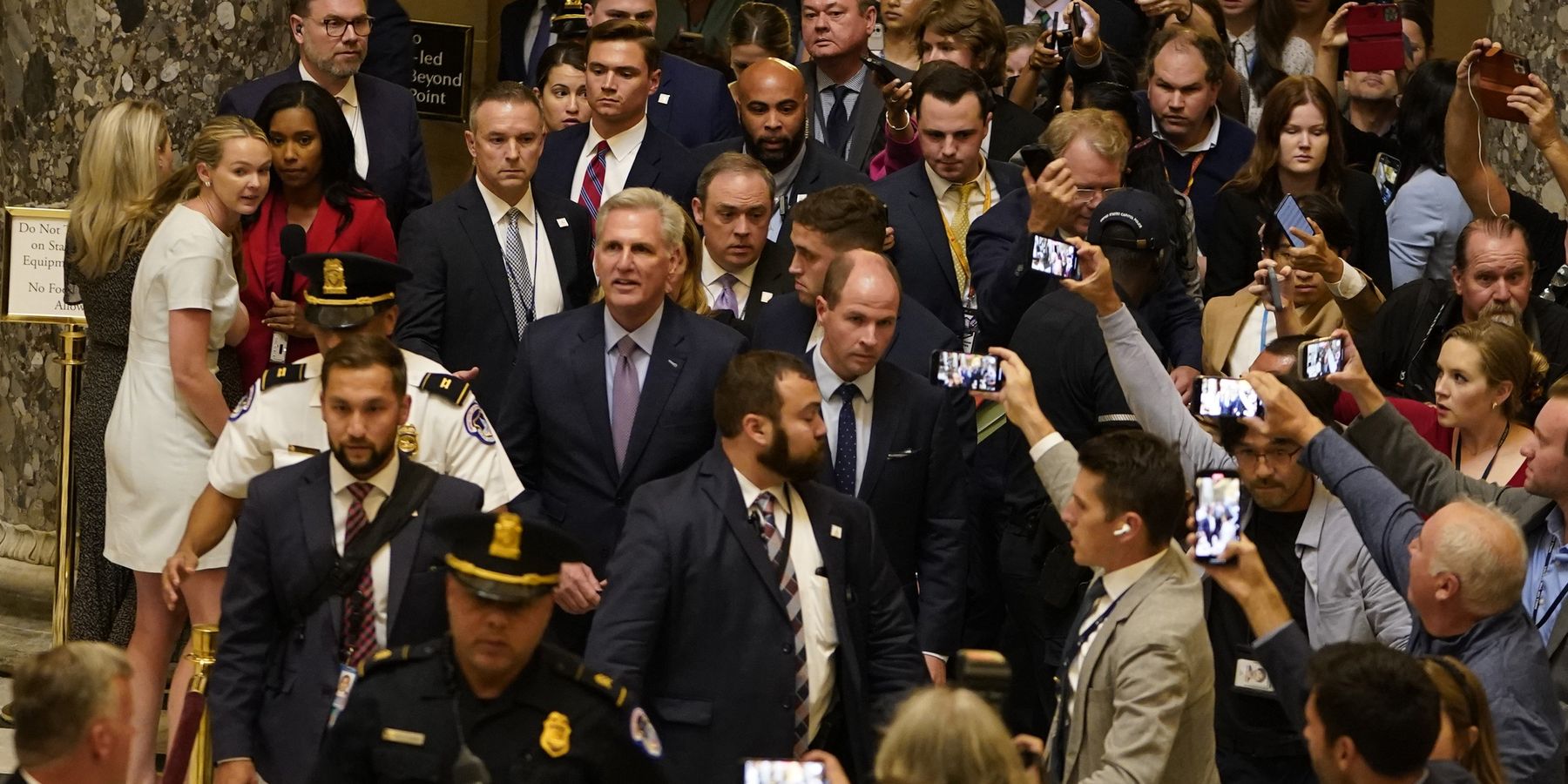The historic removal of Rep. Kevin McCarthy (R-Calif.) from the House Speakership on Wednesday introduced a new roadblock to the prospect of future aid for Ukraine’s war effort.
Funding for Ukraine emerged as a centerpiece in the negotiations to pass government spending bills and avoid a government shutdown in recent weeks, and McCarthy’s maneuvering last weekend was ultimately not enough to save his job.
The race for who will take his spot has begun, with Reps. Jim Jordan (R-Ohio) and Steve Scalise (R-La.) already throwing their hats into the ring and others, like Rep. Kevin Hern (R-Okla.) are rumored to be interested as well. One attribute that all share is reluctance to provide more aid to Ukraine, at least in the immediate future.
“Looking at the Republican candidates for speaker, I have a tough time seeing any of them bringing Ukraine funding to the floor — even with strings,” wrote Punchbowl News’ Jake Sherman on the social media platform X. Sherman later added that he “would be surprised if the W.H. gets another Ukraine aid package this year.”
The reluctance stems from the growing opposition in the GOP caucus to continuing to provide aid for Ukraine. During the Pentagon Appropriations Act amendment process last month, just over half of Republican House members voted against including $300 million in Ukraine aid, and a handful of members maintained that they would not vote for any government spending bills that included money for Ukraine.
After much back-and-forth, McCarthy had seemingly acquiesced to the bloc of House Republicans who are skeptical of funding Ukraine. The 45-day Continuing Resolution, which passed with the support of 209 Democrats and 126 Republicans over the weekend, did not contain any further money for Kyiv. But the issue was still a major reason for McCarthy’s ouster, with Rep. Matt Gaetz (R-Fla.), the leader of the revolt, accusing the former Speaker of working with President Joe Biden behind the scenes to ensure that Ukraine funding would ultimately be brought to the floor.
“Members of the Republican party might vote differently on a motion to vacate if they heard what the speaker had to share with us about his secret side deal with Joe Biden on Ukraine. I’ll be listening,” Gaetz said earlier this week, before introducing the motion to vacate. On Sunday, Biden said that he expected McCarthy to “keep his word and secure the passage of support for Ukraine at this critical moment.”
McCarthy was eventually removed from his leadership position, with eight Republicans joining forces with every voting Democrat to vacate the speakership. It marked the first time ever that a “motion to vacate” had been successfully employed to remove a House Speaker from power.
But if the next Speaker refuses to bring Ukraine aid up to a vote, supporters of sending more aid to Ukraine could have a couple of procedural options that would allow them to supersede the Speaker.
One is a petition to discharge, a mechanism by which any House majority can bypass leadership and force floor action on a bill that has been stuck in committee. A petition to discharge would require legislation to first be introduced and be pending in a committee for 30 legislative days. Further, a petition to discharge would require the signatures of a majority of members. Even if all Democrats signed the petition, it would still need six Republicans to reach the necessary 218.
There are far more than six Republicans who are in favor of continued aid for Ukraine, but the question is whether there are six who are willing to team up with Democrats and publicly buck their party’s leadership. Because petitions to discharge always require members of the majority party to agree with the minority party’s legislative priorities, they have rarely been employed successfully.
Another option would be a maneuver known as “defeating the previous question.” Voting on the previous question is a motion used to end debate on pending legislation and therefore bringing it to an immediate vote.
If Democrats — once again with sufficient GOP help — vote to defeat the previous question on a future rule vote, it will leave the rule being voted on open to debate and amendment, which could theoretically be used to add in funding for Ukraine.
Both options were floated in the media as ways for Democrats and moderate Republicans to overcome opposition from others in the GOP during the government funding debate. Experts viewed them unlikely to happen, because it would mean that a group of Republicans would essentially declare war on party leadership. At the time, Molly Reynolds of the Brookings Institution wrote on X that any solution that relied on a bloc of Republicans joining forces with Democrats would have to be “implicitly blessed by the GOP leadership.”
Therefore, bringing future Ukraine-related legislation to the floor over a speaker’s public objection would require either rank-and-file Republicans taking a major political risk by going against them, or leadership doing so by privately endorsing the effort.
A third possibility, a close observer of the Hill tells RS, is that members who want to continue funding Ukraine strike a deal with the next Speaker, either by pairing it with conservative policy goals like border security concessions, or by trimming down the size of the aid package.
In any case, these options are all either unlikely or will take time to progress. The White House and legislators supportive of continued funding for Ukraine have argued that quickly passing another tranche of aid is essential to Kyiv’s effort.
“We cannot under any circumstances allow America’s support for Ukraine to be interrupted,” Biden said on Sunday after the stopgap funding measure was passed. “We have time, not much time, and there’s an overwhelming sense of urgency,” President Joe Biden said Sunday.
On Tuesday, eight Senate Democrats sent a letter to House and Senate leadership, saying that “now is not the time to slow our aid to Ukraine.”
“It is past time for the U.S. Congress to take up and pass legislation guaranteeing Ukraine has the critical resources necessary to continue defending themselves against Putin’s illegal war,” they wrote. “We urge you to act immediately to advance legislation that will provide critical and sustained security and economic support for Ukraine to the President’s desk for his signature.”
Proponents of expediting the next package argue that the money that Washington has already sent to Kyiv is quickly drying up, though as Responsible Statecraft has reported this week, the reality is more complex.
Sen. Mark Warner, (D-Va.) noted on Tuesday that he does not have “100% clarity,” on how much of the roughly $62 billion that has been appropriated for military aid remains.
Given the events in recent months, the path forward for more Ukraine aid already seemed tricky. With House leadership in turmoil, it now appears to be even more daunting.
- Ukraine aid fight is central to government shutdown debate ›
- Speaker McCarthy drops 'blank check' for 'full support' of Ukraine aid ›
- Wait, how much Ukraine aid money does the US have left? ›
















